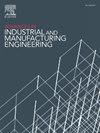厚复合材料层合板动态固化过程中防止热超调的分析准则
IF 6
Q2 ENGINEERING, INDUSTRIAL
Advances in Industrial and Manufacturing Engineering
Pub Date : 2024-12-24
DOI:10.1016/j.aime.2024.100156
引用次数: 0
摘要
热固性树脂在固化过程中的局部过热很可能发生在厚层板或在快速固化过程中。过热可能导致沿层压板厚度的机械性能不均匀,甚至导致不受控制的反应。为了避免过热,大多数热固性树脂制造商推荐一个“安全”的固化周期。然而,这些固化周期可以改进,以缩短薄层板的固化时间,而在厚层板中可能不足以避免过热。在本文中,我们提出了一个新的分析模型来确定当层压板以恒定速率加热到恒定温度时发生热失控的临界厚度。该模型考虑了模具和层压板之间的不同热边界,即从完美的热接触到无限电阻的接触。通过对VTC401环氧树脂与M55J碳纤维复合材料的厚层板固化过程进行数值积分,验证了该分析模型的有效性。模型预测表明,在制造商推荐的固化周期下,初始加热速率为2 K/min,厚度大于12.4 mm的层压板会发生热失控,这与实验观察结果一致。超过这个阈值的20mm厚层压板,根据我们的标准,使用0.3 K/min的加热速率进行固化,成功地防止了过热。实验记录的最大温度梯度保持在1°C以下,证实了模型对均匀热化的预测。本文章由计算机程序翻译,如有差异,请以英文原文为准。
Analytical criterion to prevent thermal overshoot during dynamic curing of thick composite laminates
Local overheating during curing of thermosetting resins is likely to occur for thick laminates or during fast curing. Overheating may lead to heterogeneous mechanical properties along the laminate thickness or even to an uncontrolled reaction. To avoid overheating, most thermoset resin manufacturers recommend a “safe” cure cycle. However, these cure cycles can be improved to shorten cure times in thin laminates and may not be good enough to avoid overheating in thick laminates. In this paper, we propose a new analytical model to determine the critical thickness above which thermal runaway occurs when the laminate is heated at a constant rate up to a constant temperature. The model considers different thermal boundaries between the mould and the laminate, i.e., from a perfect thermal contact to a contact of infinite resistance. The analytical model was corroborated through the numerical integration of the equations governing it and experimental data from the curing process of a thick laminate composed of the commercial VTC401 epoxy resin and M55J carbon fiber system. Model predictions indicate that, under the manufacturer's recommended cure cycle, which includes an initial heating rate of 2 K/min, thermal runaway occurs in laminates thicker than 12.4 mm, aligning with experimental observations. A 20-mm-thick laminate, exceeding this threshold, was cured using a reduced heating rate of 0.3 K/min based on our criteria, successfully preventing overheating. The maximum temperature gradient recorded experimentally remained below 1 °C, confirming the model's prediction of uniform thermalization.
求助全文
通过发布文献求助,成功后即可免费获取论文全文。
去求助
来源期刊

Advances in Industrial and Manufacturing Engineering
Engineering-Engineering (miscellaneous)
CiteScore
6.60
自引率
0.00%
发文量
31
审稿时长
18 days
 求助内容:
求助内容: 应助结果提醒方式:
应助结果提醒方式:


